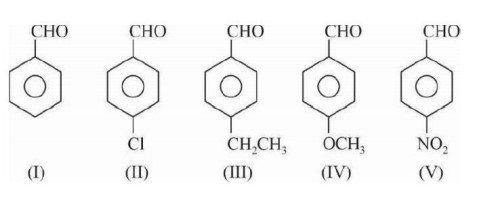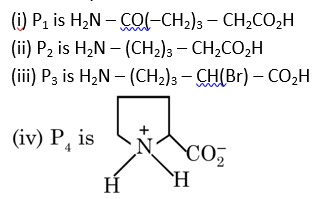Biomolecules
Get insights from 151 questions on Biomolecules, answered by students, alumni, and experts. You may also ask and answer any question you like about Biomolecules
Follow Ask QuestionQuestions
Discussions
Active Users
Followers
New answer posted
2 months agoContributor-Level 6
Different functions of biomolecules include storing genetic information (by nucleic acids), providing energy (by carbohydrates), and building and repairing tissue (by proteins).
New answer posted
2 months agoContributor-Level 10
Sucrose D (+) glucose + D (-) Fructose
Thus rotation changes from positive to negative after hydrolysis. Due to this reason hydrolysis of sucrose is known as inversion and mixture after hydrolysis is known as invert sugar.
Therefore option (B) is correct.
New answer posted
2 months agoContributor-Level 10
Key point: Fehling solution do not oxidise aromatic aldehydes, except when EWG present
at O/P position So (I), (III), (IV) not show this test
New question posted
2 months agoNew answer posted
2 months agoContributor-Level 7
There are various types of enzymes, including lyases, ligases, isomerases, hydrolases, oxidoreductases, etc. To know about the types of enzymes in detail, refer to the article.
New answer posted
2 months agoContributor-Level 7
Enzymes found in human bodies are
Lipases: They remove the fats in the gut.
Amylase: It is present in the saliva. The role of amylase is to break down carbohydrates.
Maltase: These enzymes are found in the small intestine. It breaks down the sugar maltose into glucose.
Trypsin: These enzymes are present in the small intestine. The function of trypsin is to break proteins into amino acids.
Lactase: The function of lactase is to break down lactose into simpler sugars (glucose and galactose). Lactose is the sugar that is found in dairy products.
New answer posted
2 months agoContributor-Level 7
We can define enzymes as biocatalysts. It is important in biological processes like digestion, metabolism, and the synthesis of cellular components. If enzymes stop their functions, then the body can not generate enough proteins, which is important for survival. The examples of enzymes are lactase and amylase.
New answer posted
2 months agoContributor-Level 6
Biomolecules in class 12 Chemistry include the following important topics: classification and structure of carbohydrates, amino acids, and proteins, enzymes and their characteristics, nucleic acids (DNA and RNA structure and components), and vitamins.
You must also prepare the following topics that are frequently asked in exams: zwitterion structure in amino acids, enzyme action mechanisms, and differences between DNA and RNA.
Taking an Exam? Selecting a College?
Get authentic answers from experts, students and alumni that you won't find anywhere else
Sign Up on ShikshaOn Shiksha, get access to
- 65k Colleges
- 1.2k Exams
- 679k Reviews
- 1800k Answers



